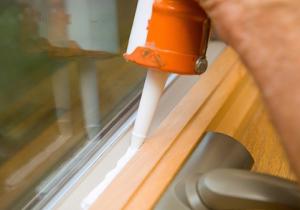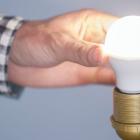Weather-stripping: Stop losing money by sealing windows and leaks
Submitted by Lara Isaacson on | Updated Thu, 15/06/2017 - 22:34

You may not have money to remodel your home to save energy. However there is one simple thing to do, you can fix air leaks with weather-stripping and caulking. Seal up crack between your toasty interior and windy exterior. This can greatly reduce your homes energy usage through more efficient heating and cooling. Of course, lowering energy usage saves you money and lowers your carbon footprint.
What's in it for you and the planet
Many homes constantly leak their temperature-controlled air and take in outside weather even if they don’t feel drafty. With the windows and doors closed, there can still be hidden gaps around window or doorframes, between the baseboards, floorboards, and by outlets. Didn’t your parents tell you not to, “heat the great outdoors!” Turns out, they were right on the money.
You can save 5-10% on your energy bill or 7.5% on average by fixing air leaks with weather-stripping and caulking. Instead of giving an extra $48-$139 to your energy company why not use it for something nice for yourself!
What are the savings for sealing windows and leaks?
| Heating Fuel | Heating Oil | Gaz | Electricity |
| Initial Cost 1, 2 | $10-$40 | $10-$40 | $10-$40 |
| How Long to Get Your Money Back 3, 4 | 1 year or less | 1 year or less | 1 year or less |
| Average Dollar Savings During Winter 3, 4 | $139 | $48 | $72 |
| Average CO2 Savings During Winter 3, 4, 5 | 1023 lbs | 569 lbs | 714 lbs |
How to fix the leaks with weather-stripping and caulking
To fix leaks, there are a couple of methods you can use: weather-stripping, caulking and for bigger holes, spray foam or other insulation may be in order.
Even the small gaps, over time can bring in or leak out a lot of air, so you’ll want to know where gaps and leaks commonly occur.
- Around windows and doors.
- Around built-in light fixtures, particularly on the celling.
- Around the chimney.
- Around the attic door.
- Gaps in the attic or basement.
- Around plumbing as it enters a room.
- Between the wall and the floor.
- Around electrical outlets, boxes, or other items cut into the wall.
(Sources for this list: Green Building Advisor, House Logic, and The Washington Post)
Now the solutions. First off, caulking can be applied to some of those common areas where gaps may occur or obviously are. This will help you keep your desired interior atmosphere. Caulking is a flexible material that is applied as a gel-like substance but dries into a fairly flexible material that holds it’s shape.
Therefore caulking should not be used for areas that need to move often. In other words, don’t use caulking between your door and the floor, you will glue your door shut. Caulking can be purchased from you local hardware store, usually for less than $10 USD ($13 CAD). A caulking gun can also be purchased for $5-$20 USD ($6.50-$26 CAD) if you want it.
Another method for closing up the gaps is adding weather stripping. Weather-stripping is meant to close the gaps where things do move. It is perfect for doorways and windows as it is a taut material that is only attached to one side of the gap - for example only the door, not the floor - allowing the door to continue to sweep across the floor with ease.
One important thing to remember about sealing the leaks is getting the right product for the job. If you’re applying caulking on the exterior of your home, make sure to ask at the store for a type of caulking that can withstand the weather conditions where you live. The same goes for weather-stripping. There are various materials used for weather-stripping different areas of your home. Cost of weather-stripping will vary with the material, but you’re not likely to spend a lot, especially compared to what you could save on your energy bill.
To recap using the above list, here are some recommendations for the type of weather-stripping that can be done for these common leaks. Note, you individual home and situation may warrant different methods.
- Around windows and doors use caulking for parts that don’t move and weather-stripping for parts that do move.
- Around built-in light fixtures, particularly on the celling use caulking.
- Around the chimney, use fire-proof flashing (which is just like weather-stripping but for the fire place) or high heat caulking. (Important: I highly recommend getting professional advice on this one, and I do not recommend getting on your roof or playing with fireplaces without prior knowledge, experience, and/or professional help.)
- Around the attic door use weather-stripping.
- Gaps in the attic or basement can be covered with caulking or foam if the leaks are too large.
- Around plumbing as it enters a room use caulking or foam.
- Between the wall and the floor use caulking.
- Around electrical outlets, boxes, or other items cut into the wall use caulking.
For other energy saving DIYs visit Energy.gov
You can do it!
As you have seen you don’t need a big budget to help you lower your expenses and carbon footprint. With a couple of DIY caulking and weather-stripping projects, you can be on your way to saving money and the environment. So plan that weekend project while you are still thinking about it!
If you really want to fix all the invisible leaks, you can get a professional inspection to help you find where air escapes. They can do a blower door test and suck air out of the house while looking through an infrared camera or using a smoke pencil to find all the leaks. After the leaks are found, you can rest assured that you know where to apply the caulking and weather-stripping.
By simply caulking and applying weather-stripping in spots that typically leak you'll be able to save 5-10% of your home heating costs in only an hour or two. Following these simple instructions for caulking and these for weather stripping will make a big impact with little effort. As far as DIY home improvement projects go, this one is a breeze.
Essentially, you find were the gaps are or simply focus on the areas where two different pieces of material meet. This could be where you floor meets your door for weather-stripping or where your window frame meets the wall. Carefully apply the caulking or weather-stripping to the crack, crevice, or joint, and voila, you’re on your way to savings! If using caulking, you can push the caulking further into the crack and take off excess by sweeping your finger along the crack right after you have applied it. There are plenty of instructions videos online if (like me) you’d rather see someone do it before you do it.
Eco Bonus
On the topic of air, it is also important to be aware of air quality effect and pollution from the products we buy. It’s not just the project but the quality of the product used in the project that make the positive difference. Look for low and ultra-low VOC (Volatile Organic Compound) products. VOCs can have serious negative health effects and create ground-level ozone which also has negative health effects, especially at higher temperature.
Specifically for your weather-stripping, look for ultra-low VOC caulking and/or spray foam in order to prevent toxic fumes in your home while doing these environmentally-friendly projects. If you need more insulation to stop the leaks, there are environmentally-friendly options for large scale projects, such as recycled denim insulation. Additionally, there are some recycled material options for weather-stripping to help green that project as well.
Please post in the comments with any comments, questions, or suggestions!
Happy fixing!
Sources:
1) http://energy.gov/energysaver/projects/savings-project-how-weatherstrip-...
2) http://www.energy.gov/energysaver/articles/energy-saving-do-it-yourself-...
3) http://energy.gov/energysaver/projects/savings-project-how-seal-air-leak...
4) http://www.eia.gov/forecasts/steo/
5) https://www.eia.gov/environment/emissions/co2_vol_mass.cfm
You will save the Earth by sharing and/or tweeting (corny right?)





